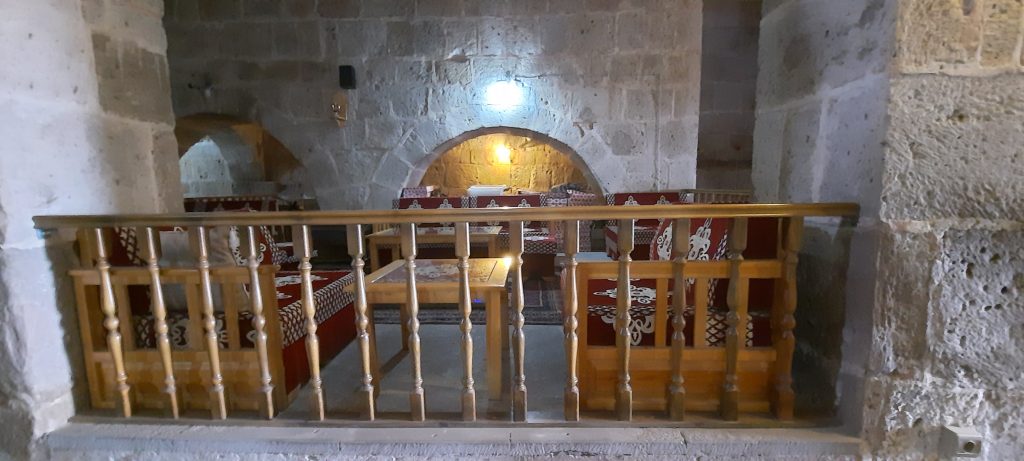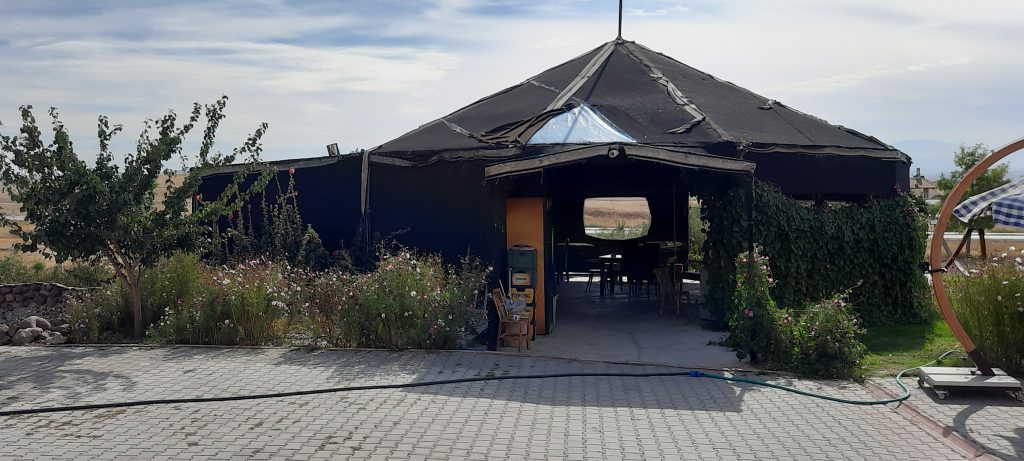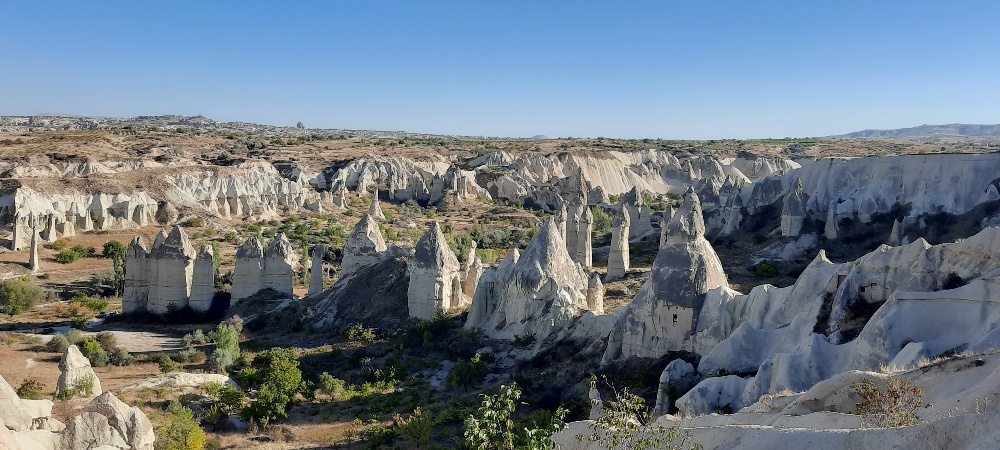
Our tour started in Antalya, from there we travelled the 540K to Cappadocia by coach. Our first main stop was at Konya which is a pilgrimage destination for Sufis, focused on the tomb of the founder of the Mevlana order, Jalal ad-Din Muhammad Rumi, the peace-loving Persian Sufi poet and mystic who founded the bizarre sect known as the ‘whirling dervishes’ and lived between 1207 and 1273. The museum is in a former monastery constructed around the mausoleum. It is one of the most popular pilgrimage destinations in Turkey, with more than 1.5 million people visiting each year. The highly ornate monastery was built in the 16th century around the 13th-century tomb of Rumi and has slender minarets, several domes and a bright-turquoise tiled tower, which is one of the landmarks of the city. The complex includes prayer rooms, a library stocked with thousands of rare ecclesiastical books and Koran manuscripts, the monks’ cells and kitchens, all situated in manicured gardens full of shrubs, roses and a blue-and-white marble fountain. At the heart of the monastery lies the sarcophagus of Rumi, accompanied by the tombs of his wife, children and several of his followers; it stands in the marble mausoleum built to a design by architect Behrettin Tebrizli in 1274.

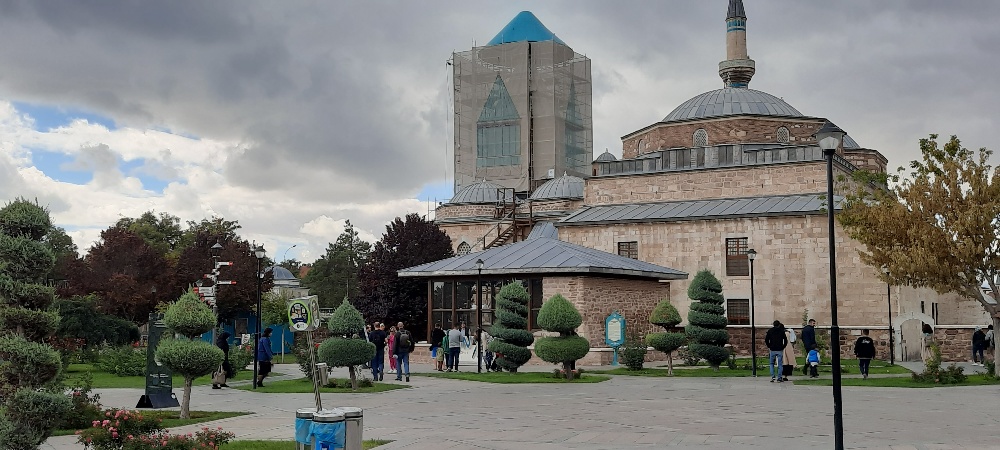

Our next stop was at Sultanhanı Caravanserai. Caravanserais, large guest houses for travelling merchants and their caravans, were dispersed along the land routes of the Silk Roads. Found extensively from Turkey to China, caravanserai provided not only food and shelter but also an opportunity for merchants and others travelling to exchange goods, access local markets and meet and interact with people from across the vast regions encompassed by the Silk Roads. By offering such an intercultural environment, caravanserai were important sites for the exchange of material culture, languages and ideas.

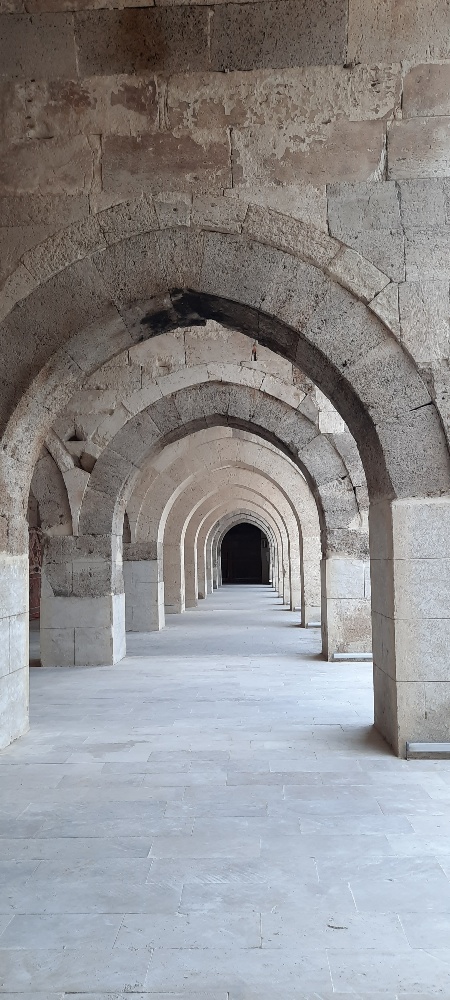

Finally we arrived at the Avrasya hotel in Avanos. Here we had the opportunity to take an early morning hot air balloon flight over Cappadocia. Up to 100 balloons are allowed to take off before sunrise, and another 50 are granted permission to take off half an hour after sunrise, most of the balloon baskets take about 25 people. Balloons are registered with the aviation authority and subject to regular safety checks to ensure airworthiness. Pilots for hot air balloons in Cappadocia must also undergo examinations, have a prescribed number of flight hours under his or her belt, pass flight tests as well as ace their medical checks.

The next morning we were woken up at 4:30 AM and had a light breakfast at the hot air balloon company’s office, driven to the take-off site and watched the balloons fill up with hot air. The balloon doesn’t rock or sway, so you don’t really feel that you’re leaving the ground and the views are a great way to distract yourself from the fact that you’re floating hundreds of metres off the ground. The balloons can go up to about 800 metres and also get right down into valleys full of “fairy chimney” rock formations and Goreme town. Hot air balloons go with the wind and the flight trajectory is almost entirely dependent on wind speed and direction, landings take place on any large, flat(ish) area including parks, empty fields, school grounds or roads. “Chase crews” follow the balloon via radio contact with the pilot so that they can meet you at the landing site with the balloon trailer, in our case the pilot landed the balloon right on the trailer. After another breakfast back at the hotel our next stop on day 2 was at the amazing Guray underground ceramic museum.
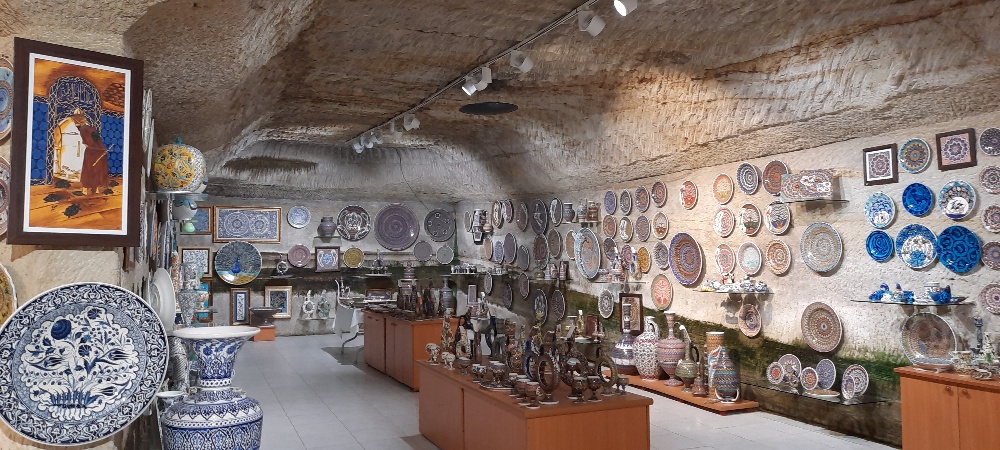
Next we visited a private cave house.

In the center of Turkey, in the area of Cappadocia, an ancient eruption of volcanoes left the area covered in a layer of tufa, a soft rock up to one hundred meters thick. Three volcanoes, Erciyes, Hasan and Melendiz Daðlari erupted around 30 million years ago. Thousands of years ago the people of this area started to build houses, churches and underground cities into the volcanic tufa. It was not too difficult to build, as the tufa is very soft, and the housings are comfortable, warm in winter and cool in summer. By the 4th century, Cappadocia was largely inhabited by monks and many of their excavated homes can be found in ‘monks valley’

The Fairy Chimneys in monks valley are certainly the most impressive of the Cappadocia region, some pillars are 15 meters tall and split into twin chimneys, some even support three chimneys. The mushroom-shaped pillars have formed due to the effects of wind and rain on the soft rock but they have become widely known as fairy chimneys; legends say they were built by the fairies for their underground homes.
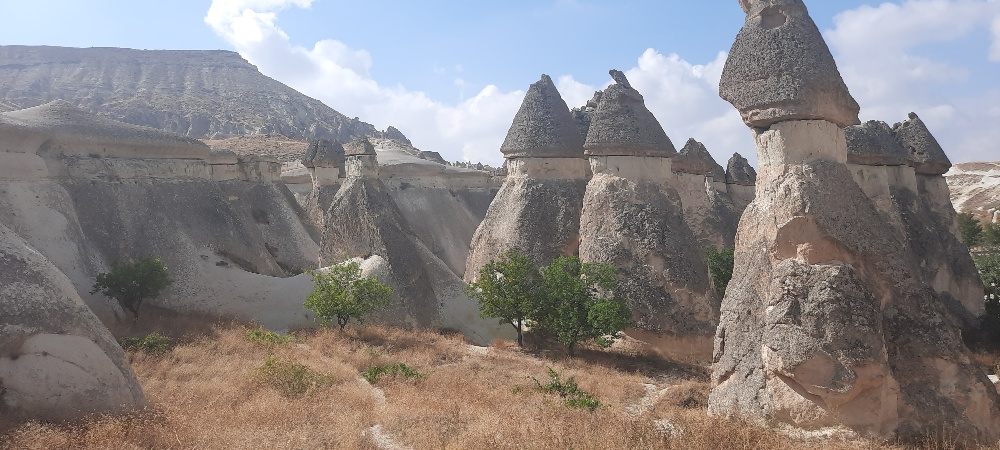
We then had a short stop for a walk around the village of Mustafapasa which previously had a large Greek community and was known as Sinasos, before heading to the highlight of the afternoon, a whirling dervish ceremony.

The dervishes wear tall conical hats and black mantles, some of them start playing musical instruments, then the others, rising slowly, move to greet the shaykh, or master, and cast off the black coat to emerge in white shirts and waistcoats. They keep their individual places with respect to one another and begin to revolve rhythmically. They throw back their heads and raise the palms of their hands, a symbol of giving and taking.
The rhythm accelerates, and they whirl faster and faster. In this way they enter a trance in an attempt to lose their personal identities and to attain union with the Almighty. Later they may sit, pray, and begin all over again.
The following morning our first stop was at the castle rock of Uchisar and pigeon valley for stunning photos.
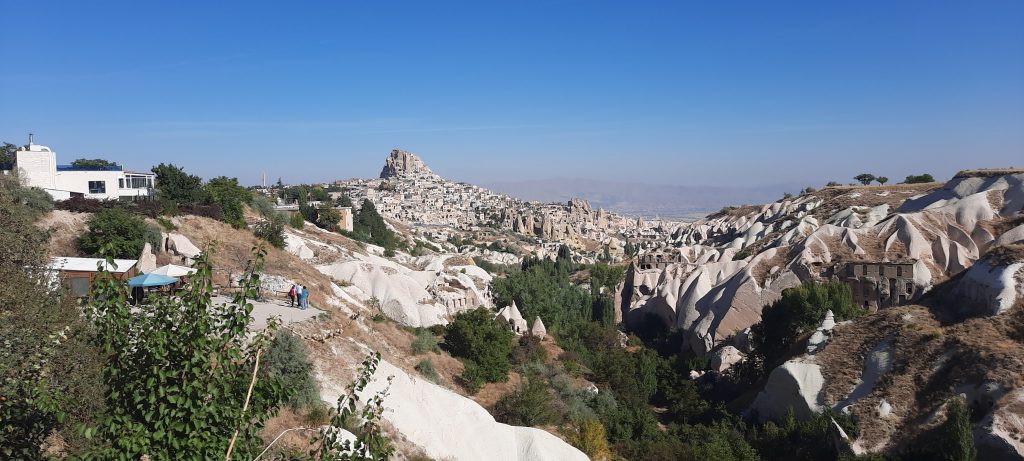
Then after lunch the highlight of Cappadocia, the Goreme open air museum. The museum contains several churches which were dug into the rocks, and richly decorated with colourful frescoes. The Apple Church is a smaller cave church which was built around 1050 and has carved into four irregular pillars the sign of a Greek cross with these pillars support its central dome. The Church of Saint Barbara was built in the late 11th Century as a tribute to the Martyr-Saint. The Snake Church is a simple barrel-vaulted church with a low ceiling and long nave. It is named for the fresco of Saints Theodore and St George slaying the dragon or snake as depicted in the fresco. The Dark Church was a monastic compound built in the 11th century.
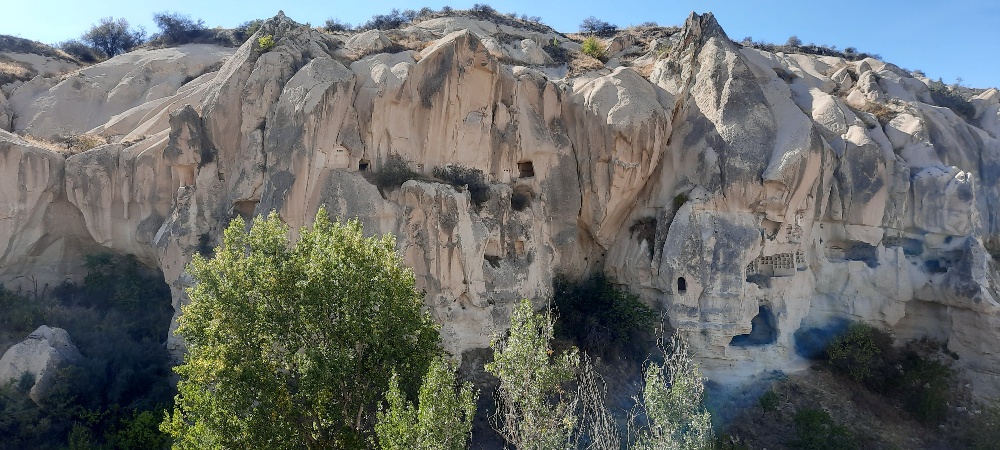
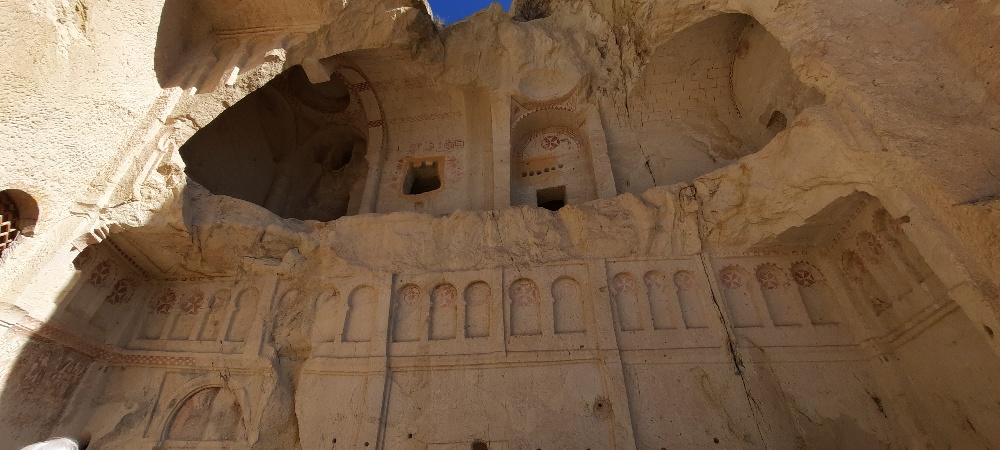

Our next stop was ‘love valley’ and another photo opportunity before heading off to a family tea garden. That evening we treated to a Cappadocian Turkish night with a variety of Turkish dances, authentic costumes, and folklore music.

On our final day in Cappadocia we visited an underground city, this involved squeezing through some small tunnels. These underground cities were first built in the 8th–7th centuries BC, according to the Turkish Department of Culture then greatly expanded when used for protection from Muslim Arab raids during the four centuries of Arab–Byzantine wars (780–1180) and the underground cities are a good hideout in wartimes. Several underground cities in this area were built in this manner, having up to one thousand inhabitants each and up to 100 tunnels on up to 18 separate levels. Around 200 separate underground structures have been found so far. Thirty-six are big enough to be called underground cities.

And so we made our way back to Antalya calling at a different Caravanserai on the way.
